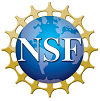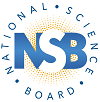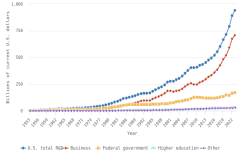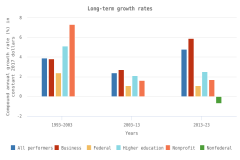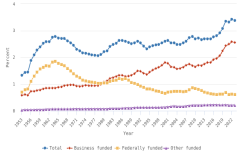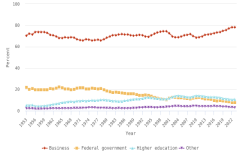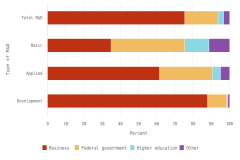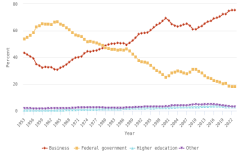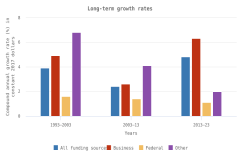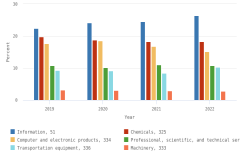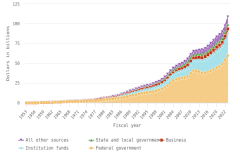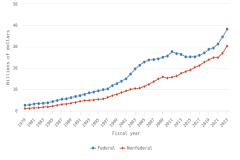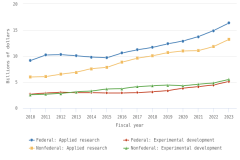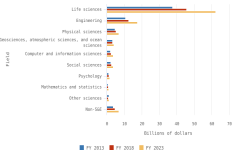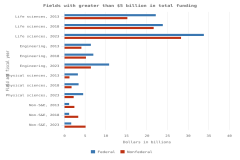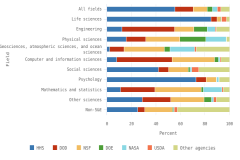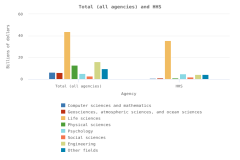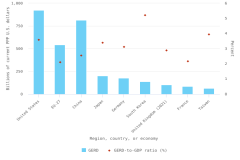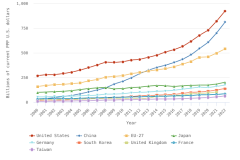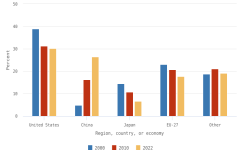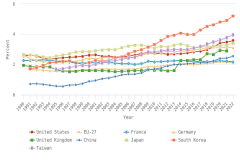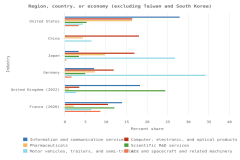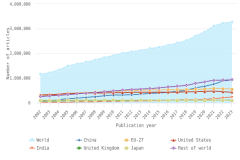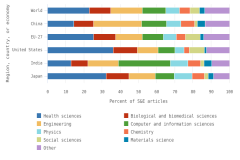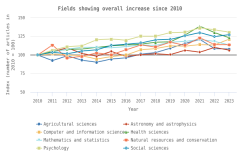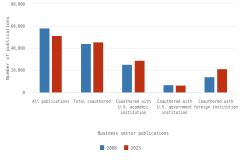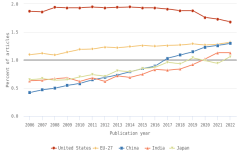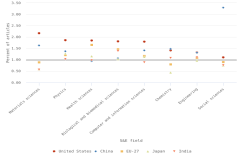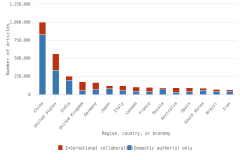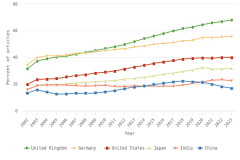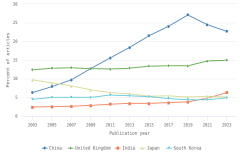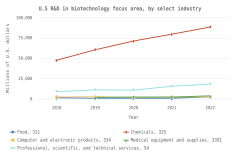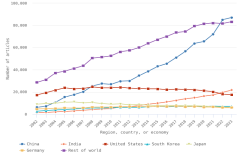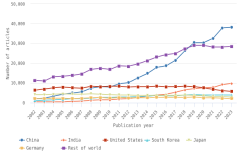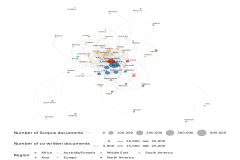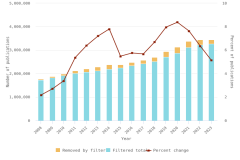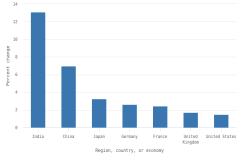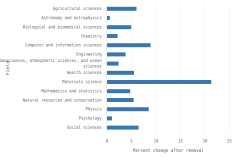References
Adams JD. 1990. Fundamental Stocks of Knowledge and Productivity Growth. Journal of Political Economy 98(4):673–702. Available at http://www.jstor.org/stable/2937764. Accessed 24 January 2024.
Ahmadpoor M, Jones BF. 2017. The Dual Frontier: Patented Inventions and Prior Scientific Advance. Science 357:583–87.
Akcigit U, Hanley D, Serrano-Velarde N. 2021. Back to Basics: Basic Research Spillovers, Innovation Policy, and Growth. Review of Economic Studies 88(1):1–43.
Aksnes DW, Sivertsen G, van Leeuwen TN, Wendt KK. 2017. Measuring the Productivity of National R&D Systems: Challenges in Cross-National Comparisons of R&D Input and Publication Output Indicators. Science and Public Policy 44(2):246–58. Available at https://doi.org/10.1093/scipol/scw058. Accessed 24 January 2024.
Anderson G, Jankowski J, Boroush M; National Center for Science and Engineering Statistics (NCSES). 2023. U.S. R&D Increased by $51 Billion in 2020 to $717 Billion; Estimate for 2021 Indicates Further Increase to $792 Billion. NSF 23-320. Alexandria, VA: National Science Foundation. Available at https://ncses.nsf.gov/pubs/nsf23320.
Anderson G, Kindlon A; National Center for Science and Engineering Statistics (NCSES). 2019. Indicators of R&D in Small Businesses: Data from the 2009–15 Business R&D and Innovation Survey. InfoBrief NSF 19-316. Alexandria, VA: National Science Foundation. Available at https://www.nsf.gov/statistics/2019/nsf19316/.
Arora A, Belenzon S, Cioaca LC, Sheer L, Zhang H. 2023. The Effect of Public Science on Corporate R&D. Working Paper 31899. Cambridge, MA: National Bureau of Economic Research.
Arora A, Belenzon B, Sheer L. 2021. Knowledge Spillovers and Corporate Investment in Scientific Research. American Economic Review 111(3):871–98.
Baily MN, Bosworth B, Doshi S. 2020. Productivity Comparisons: Lessons from Japan, the United States, and Germany. Washington, DC: Brookings Institution. Available at https://www.brookings.edu/articles/productivity-comparisons-lessons-from-japan-the-united-states-and-germany/. Accessed 31 July 2023.
Bloom N, Jones CI, Van Reenen J, Webb M. 2020. Are Ideas Getting Harder to Find? American Economic Review 110(4):1104–44.
Boothby C, Schneider B; National Center for Science and Engineering Statistics (NCSES). 2024. International Collaboration in Selected Critical and Emerging Fields: COVID-19 and Artificial Intelligence. NSF 24-323. Alexandria, VA: National Science Foundation. Available at https://ncses.nsf.gov/pubs/nsf24323.
Brocal F, Sebastián MA, González C. 2019. Advanced Manufacturing Processes and Technologies. In Roig B, Weiss K, Thireau V, editors, Management of Emerging Public Health Issues and Risks, pp. 31–64. Amsterdam, Netherlands: Academic Press.
Bureau of Economic Analysis (BEA). 2024. Activities of U.S. Multinational Enterprises, 2022. BEA 24-37. Available at https://www.bea.gov/news/2024/activities-us-multinational-enterprises-2022. Accessed 17 November 2024.
Center for Strategic & International Studies (CSIS). 2021. National Security and the Innovation Ecosystem. Available at https://www.csis.org/analysis/national-security-and-innovation-ecosystem. Accessed 6 November 2024.
Congressional Budget Office (CBO). 2021. Research and Development in the Pharmaceutical Industry. Washington, DC. Available at https://www.cbo.gov/publication/57126. Accessed 21 October 2024.
Congressional Research Service (CRS). 2016. U.S. Semiconductor Manufacturing: Industry Trends, Global Competition, Federal Policy. Washington, DC.
Congressional Research Service (CRS). 2020. Government Expenditures on Defense R&D by the United States and Other OECD Countries: Fact Sheet. Washington, DC.
Congressional Research Service (CRS). 2022a. The Bioeconomy: A Primer. Washington, DC. Available at https://www.congress.gov/crs-product/R46881. Accessed 26 May 2025.
Congressional Research Service (CRS). 2022b. U.S. Research and Development Funding and Performance: Fact Sheet. Washington, DC.
Congressional Research Service (CRS). 2023a. Federal Research and Development (R&D) Funding: FY2024. Washington, DC.
Congressional Research Service (CRS). 2023b. Semiconductors and the Semiconductor Industry. Washington, DC.
Congressional Research Service (CRS). 2024. Made in China 2025 and Industrial Policies: Issues for Congress. Washington, DC.
Congressional Research Service (CRS). 2025. National Security Commission on Emerging Biotechnology: Final Report and Options for Congress. Washington, DC.
Crespi G, Geuna A. 2005. Modelling and Measuring Scientific Production: Results for a Panel of OECD Countries. Working Paper Series 133. Brighton, United Kingdom: Science Policy Research Unit, University of Sussex Business School.
Czarnitzki D, Thorwarth S. 2012. Productivity Effects of Basic Research in Low-Tech and High-Tech Industries. Research Policy 41(9):1555–64.
Department of Defense (DOD), Defense Science Board (DSB). 2022. Summer Study on Technology Superiority: Executive Summary. Washington, DC. Available at https://dsb.cto.mil/reports/. Accessed 6 November 2024.
Furman JL, Kyle MK, Cockburn I, Henderson RM. 2005. Public & Private Spillovers, Location and the Productivity of Pharmaceutical Research. Annales d’Économie et de Statistique 79/80:165–88. Available at https://doi.org/10.2307/20777574. Accessed 17 February 2025.
Garfield E. 1973. Citation Frequency as a Measure of Research Activity and Performance. Current Contents 5:406–8. Available at http://garfield.library.upenn.edu/essays/V1p406y1962-73.pdf. Accessed 24 March 2023.
Gibbons MT; National Center for Science and Engineering Statistics (NCSES). 2024a. Higher Education R&D Expenditures Increased 11.2%, Exceeded $108 Billion in FY 2023. NSF 25-313. Alexandria, VA: U.S. National Science Foundation. Available at https://ncses.nsf.gov/pubs/nsf25313.
Gibbons MT; National Center for Science and Engineering Statistics (NCSES). 2024b. Science and Engineering Research Space at Academic Institutions Totaled 240 Million Square Feet in FY 2023. NSF 25-318. Alexandria, VA: U.S. National Science Foundation. Available at https://ncses.nsf.gov/pubs/nsf25318.
Glänzel W, Schubert A. 2005. Domesticity and Internationality in Co-Authorship, References and Citations. Scientometrics 65(3):323–42.
Grudniewicz A, Moher D, Cobey KD, Bryson GL, Cukier S, Allen K, Ardern C, Balcom L, Barros T, Berger M, Buitrago Ciro J, Cugusi L, Donaldson MR, Egger M, Graham ID, Hodgkinson M, Khan KM, Mabizela M, Manca A, Milzow K, Mouton J, Muchenje M, Olijhoek T, Ommaya A, Patwardhan B, Puff D, Proulx L, Rodger M, Severin A, Strinzel M, Sylos-Labini M, Tambluyn R, van Miekerk M, Wicherts JM, Lal MM. 2019. Predatory Journals: No Definition, No Defence. Nature 576:210–12. Available at https://www.nature.com/articles/d41586-019-03759-y?fbclid=IwAR30GTZSaMn_D7bPyeQtk5hHdDXlcD4-hq8Mcl37TXX0PpjB1Tw4sYpSxjA. Accessed 28 August 2023.
Hicks D. 1995. Published Papers, Tacit Competencies and Corporate Management of the Public/Private Character of Knowledge. Industrial and Corporate Change 4(2):401–24. Available at https://doi.org/10.1093/icc/4.2.401. Accessed 25 March 2025.
Hughes A; National Center for Science and Engineering Statistics (NCSES). 2024. Business R&D Performance in the United States Nears $700 Billion in 2022. NSF 24-334. Alexandria, VA: U.S. National Science Foundation. Available at https://ncses.nsf.gov/pubs/nsf24334.
Jorgenson DW. 2001. Information Technology and the U.S. Economy. American Economic Review 91(1):1–32.
Kindlon A; National Center for Science and Engineering Statistics (NCSES). 2024. Microbusinesses Performed $5.7 Billion of R&D in the United States in 2022. NSF 25-302. Alexandria, VA: U.S. National Science Foundation. Available at https://ncses.nsf.gov/pubs/nsf25302.
Kindlon A, Anderson G, Rhodes A; National Center for Science and Engineering Statistics (NCSES). 2024. Critical and Emerging Technologies by U.S. Businesses: Use and R&D Funding and Performance. NSF 25-307. Alexandria, VA: U.S. National Science Foundation. Available at https://ncses.nsf.gov/pubs/nsf25307.
Knott AM, Vieregger C. 2020. Reconciling the Firm Size and Innovation Puzzle. Organization Science 31(2):477–88. Available at https://doi.org/10.1287/orsc.2019.1310. Accessed 24 January 2025.
Kolev J, Haughey A, Murray F, Stern S. 2022. Of Academics and Creative Destruction: Startup Advantage in the Process of Innovation. Working Paper No. 30362. Cambridge, MA: National Bureau of Economic Research.
Luukkonen T, Tijssen RJW, Persson O, Sivertsen G. 1993. The Measurement of International Scientific Collaboration. Scientometrics 28:15–36. Available at https://doi.org/10.1007/BF02016282. Accessed 28 August 2023.
Lyons E, Colglazier EW, Wagner CS, Börner K, Dooley DM, Mote CD Jr, Roco MC. 2016. How Collaborating in International Science Helps America. Science & Diplomacy 5(2).
Merton RK. 1973. The Sociology of Science: Theoretical and Empirical Investigations. Chicago, IL: University of Chicago Press.
Moris F; National Center for Science and Engineering Statistics (NCSES). 2019. Software R&D: Revised Treatment in U.S. National Accounts and Related Trends in Business R&D Expenditures. InfoBrief NSF 19-315. Alexandria, VA: National Science Foundation. Available at https://www.nsf.gov/statistics/2019/nsf19315/.
Moris F; National Center for Science and Engineering Statistics (NCSES). 2021. Foreign R&D Reported by IT-Related Industries Account for About Half or More of U.S.-Owned R&D Performed in India, China, Canada, and Israel. InfoBrief NSF 22-328. Alexandria, VA: National Science Foundation. Available at https://ncses.nsf.gov/pubs/nsf22328/.
Moris F, Rhodes A; National Center for Science and Engineering Statistics (NCSES). 2024a. Six States Perform around 90% of Semiconductor Business R&D, Led by California. NSF 24-329. Alexandria, VA: U.S. National Science Foundation. Available at https://ncses.nsf.gov/pubs/nsf24329.
Moris F, Rhodes A; National Center for Science and Engineering Statistics (NCSES). 2024b. U.S. Business R&D in Semiconductor-Related Industries. NSF 25-304. Alexandria, VA: U.S. National Science Foundation. Available at https://ncses.nsf.gov/pubs/nsf25304.
Mowery DC. 1992. The U.S. National Innovation System: Origins and Prospects for Change. Research Policy 21(2):125–44.
Moylan CE, Okubo S. 2020. The Evolving Treatment of R&D in the U.S. National Economic Accounts. Working Paper. Suitland, MD: Bureau of Economic Analysis. Available at https://www.bea.gov/sites/default/files/2020-04/the-evolving-treatment-of-rd-in-the-us-national-economic-accounts.pdf. Accessed 6 August 2023.
Nanotech Powers On-Chip Intelligence. 2025. Nature Nanotechnology 20(1). Available at https://doi.org/10.1038/s41565-025-01856-w. Accessed 17 February 2025.
National Academies of Sciences, Engineering, and Medicine (NASEM). 2020. The Endless Frontier: The Next 75 Years in Science. Washington, DC: National Academies Press. Available at https://doi.org/10.17226/25990. Accessed 12 August 2023.
National Center for Science and Engineering Statistics (NCSES). 2024a. Business Enterprise Research and Development: 2022 (BERD 2022). NSF 24-335. Alexandria, VA: U.S. National Science Foundation. Available at https://ncses.nsf.gov/surveys/business-enterprise-research-development/2022.
National Center for Science and Engineering Statistics (NCSES). 2024b. Higher Education Research and Development: Fiscal Year 2023 (HERD 2023). NSF 25-314. Alexandria, VA: U.S. National Science Foundation. Available at https://ncses.nsf.gov/surveys/higher-education-research-development/2023.
National Center for Science and Engineering Statistics (NCSES). 2025a. A Brief Annotated History of Federal R&D Obligations: FYs 1951–2024. NSF 25-332. Alexandria, VA: U.S. National Science Foundation. Available at https://ncses.nsf.gov/pubs/nsf25332.
National Center for Science and Engineering Statistics (NCSES). 2025b. Federal Funds for Research and Development: Fiscal Years 2023–24. NSF 25-328. Alexandria, VA: U.S. National Science Foundation. Available at https://ncses.nsf.gov/surveys/federal-funds-research-development/2023-2024/.
National Center for Science and Engineering Statistics (NCSES). 2025c. Federal R&D Obligations Declined 2.1% in FY 2023; Estimated to Increase in FY 2024. NSF 25-329. Alexandria, VA: U.S. National Science Foundation. Available at https://ncses.nsf.gov/pubs/nsf25329.
National Center for Science and Engineering Statistics (NCSES). 2025d. National Patterns of R&D Resources: 2022–23 Data Update. NSF 25-326. Alexandria, VA: U.S. National Science Foundation. Available at https://ncses.nsf.gov/data-collections/national-patterns/2022-2023.
National Center for Science and Engineering Statistics (NCSES). 2025e. U.S. R&D Totaled $892 Billion in 2022; Estimate for 2023 Indicates Further Increase to $940 Billion. NSF 25-327. Alexandria, VA: U.S. National Science Foundation. Available at https://ncses.nsf.gov/pubs/nsf25327/.
National Science Board (NSB), National Science Foundation. 2018. Science and Engineering Indicators 2018 (Indicators 2018). NSB-2018-1. Alexandria, VA. Available at https://www.nsf.gov/statistics/2018/nsb20181/.
National Science Board (NSB), National Science Foundation. 2020a. Vision 2030. NSB-2020-15. Alexandria, VA. Available at https://www.nsf.gov/nsb/publications/2020/nsb202015.pdf.
National Science Board (NSB), National Science Foundation. 2020b. Research and Development: U.S. Trends and International Comparisons. Science and Engineering Indicators 2020 (Indicators 2020). NSB-2020-3. Alexandria, VA. Available at https://ncses.nsf.gov/pubs/nsb20203/.
National Science Board (NSB), National Science Foundation. 2021a. Academic Science and Engineering Article Output per 1,000 Science, Engineering, and Health Doctorate Holders in Academia. Science and Engineering Indicators: State Indicators. Table S-48. Alexandria, VA. Available at https://ncses.nsf.gov/indicators/states/indicator/academic-se-articles-per-1000-seh-doctorate-holders-in-academia.
National Science Board (NSB), National Science Foundation. 2021b. Academic Science and Engineering Article Output per $1 Million of Academic Science and Engineering R&D. Science and Engineering Indicators: State Indicators. Table S-49. Alexandria, VA. Available at https://ncses.nsf.gov/indicators/states/indicator/academic-se-articles-per-1-million-in-academic-rd.
National Science Board, National Science Foundation. 2021c. Publications Output: U.S. and International Comparisons. Science and Engineering Indicators 2022 (Indicators 2022). NSB-2021-4. Alexandria, VA. Available at https://ncses.nsf.gov/pubs/nsb20214/.
National Science Board (NSB), National Science Foundation. 2022a. Higher Education in Science and Engineering. Science and Engineering Indicators 2022 (Indicators 2022). NSB-2022-3. Alexandria, VA. Available at https://ncses.nsf.gov/pubs/nsb20223.
National Science Board (NSB), National Science Foundation. 2022b. Invention, Knowledge Transfer, and Innovation. Science and Engineering Indicators 2022 (Indicators 2022). NSB-2022-4. Alexandria, VA. Available at https://ncses.nsf.gov/pubs/nsb20224/.
National Science Board (NSB), National Science Foundation. 2023. Publications Output: U.S. Trends and International Comparisons. Science and Engineering Indicators 2024 (Indicators 2024). NSB-2023-33. Alexandria, VA. Available at https://ncses.nsf.gov/pubs/nsb202333/.
Organisation for Economic Co-operation and Development (OECD). 2015. Frascati Manual 2015: Guidelines for Collecting and Reporting Data on Research and Experimental Development, 7th ed. Paris: OECD Publishing.
Organisation for Economic Co-operation and Development (OECD). 2023. Science, Technology and Innovation (STI) Outlook—Enabling Transitions in Times of Disruption. Paris: OECD Publishing.
Organisation for Economic Co-operation and Development (OECD). 2024a. Analytical Business Enterprise Research and Development (ANBERD). Available at https://www.oecd.org/en/data/datasets/analytical-business-enterprise-research-and-development.html. Accessed 27 September 2024.
Organisation for Economic Co-operation and Development (OECD). 2024b. Key Biotechnology Indicators. Available at https://www.oecd.org/en/data/datasets/emerging-technology-indicators.html. Accessed 21 April 2025.
Organisation for Economic Co-operation and Development (OECD). 2024c. INNOTAX Portal. Available at https://stip.oecd.org/innotax/. Accessed 1 November 2024.
Organisation for Economic Co-operation and Development (OECD). 2024d. Main Science and Technology Indicators (MSTI). Available at https://www.oecd.org/en/data/datasets/main-science-and-technology-indicators.html. Accessed 1 August 2024.
Pece CV; National Center for Science and Engineering Statistics (NCSES). 2023. Federal Obligations for R&D Increased Nearly 14% in FY 2021, Supported by COVID-19 Pandemic-Related Funding. NSF 23-352. Alexandria, VA: National Science Foundation. Available at https://ncses.nsf.gov/pubs/nsf23352.
Pece CV; National Center for Science and Engineering Statistics (NCSES). 2024. Federal R&D Obligations Increased 0.4% in FY 2022; Estimated to Decline in FY 2023. NSF 24-322. Alexandria, VA: National Science Foundation. Available at https://ncses.nsf.gov/pubs/nsf24322.
President’s Council of Advisors on Science and Technology (PCAST). 2020. Recommendations for Strengthening American Leadership in Industries of the Future. Washington, DC: Executive Office of the President of the United States. Available at https://science.osti.gov/-/media/_/pdf/about/pcast/202006/PCAST_June_2020_Report.pdf. Accessed 30 November 2023.
Rotolo D, Camerani R, Grassano N, Martin BR. 2022. Why Do Firms Publish? A Systematic Literature Review and a Conceptual Framework. Research Policy 51(10):104606. Available at https://doi.org/10.1016/j.respol.2022.104606. Accessed 17 February 2025.
Royal Society. 2011. Knowledge, Networks and Nations: Global Scientific Collaboration in the 21st Century. RS Policy Document 03/11. London: Royal Society.
Science-Metrix. 2019. Bibliometric Indicators for the SEI 2020. Technical Documentation. Montreal, Canada: Science-Metrix. Available at https://www.science-metrix.com/?q=en/publications/reports#/?q=en/publications/reports/bibliometric-indicators-for-the-sei-2020-technical-documentation. Accessed 28 August 2023.
Science-Metrix. 2021a. Bibliometric Indicators for the Science and Engineering Indicators 2022. Technical Documentation. Available at https://science-metrix.com/bibliometrics-indicators-for-the-science-and-engineering-indicators-2022-technical-documentation/. Accessed 28 August 2023.
Science-Metrix. 2021b. Special Tabulations of Elsevier Scopus Abstract and Citation Database. Montreal, Canada: Science-Metrix.
Shelton RD. 2008. Relations between National Research Investment and Publication Output: Application to an American Paradox. Scientometrics 74(2):191–205.
Simeth M, Raffo JD. 2013. What Makes Companies Pursue an Open Science Strategy? Research Policy 42(9):1531–43. Available at https://doi.org/10.1016/j.respol.2013.05.007. Accessed 17 February 2025.
Stephan PE. 2012. How Economics Shapes Science. Cambridge, MA: Harvard University Press.
Sugimoto CR, Larivière V. 2018. Measuring Research: What Everyone Needs to Know. Oxford, United Kingdom: Oxford University Press.
Tahamtan I, Bornmann L. 2018. Core Elements in the Process of Citing Publications: Conceptual Overview of the Literature. Journal of Informetrics 12:203–16. Available at https://doi.org/10.1016/j.joi.2018.01.002. Accessed 24 March 2023.
Thomas VJ, Sharma S, Jain S. 2011. Using Patents and Publications to Assess R&D Efficiency in the States of the USA. World Patent Information 33(1):4–10.
Tijssen RJW, Winnink JJ. 2018. Capturing ‘R&D Excellence’: Indicators, International Statistics, and Innovative Universities. Scientometrics 114:687–99. Available at https://doi.org/10.1007/s11192-017-2602-9. Accessed 17 February 2025.
Toole AA. 2012. The Impact of Public Basic Research on Industrial Innovation: Evidence from the Pharmaceutical Industry. Research Policy 41(1):1–12.
U.S.-China Economic and Security Review Commission (USCC). 2024. 2024 Report to Congress. Washington, DC: U.S. Government Publishing Office.
Van Noorden R, Maher B, Nuzzo R. 2014. The Top 100 Papers. Nature 514(7524):550–53. Available at https://doi.org/10.1038/514550a. Accessed 24 March 2023.
Wagner CS. 2018. The Collaborative Era in Science: Governing the Network. London: Palgrave Macmillan.
Wagner CS, Park HW, Leydesdorff L. 2015. The Continuing Growth of Global Cooperation Networks in Research: A Conundrum for National Governments. PLOS ONE 10(7):e0131816. Available at https://doi.org/10.1371/journal.pone.0131816. Accessed 18 October 2024.
Waltman L, van Eck NJ, Wouters P. 2013. Counting Publications and Citations: Is More Always Better? Journal of Informetrics 7(3):635–41. Available at https://www.sciencedirect.com/science/article/abs/pii/S1751157713000357. Accessed 28 August 2023.
Wang J. 2012. Citation Time Window Choice for Research Impact Evaluation. Scientometrics 94:851–72. Available at https://doi.org/10.1007/s11192-012-0775-9. Accessed 24 March 2023.
White House. 2025. A Letter to Michael Kratsios, Director of the White House Office of Science and Technology Policy. Briefings & Statements March 26. Available at https://www.whitehouse.gov/briefings-statements/2025/03/a-letter-to-michael-kratsios-director-of-the-white-house-office-of-science-and-technology-policy/. Accessed 25 April 2025.
Yin Y, Dong Y, Wang K, Wang D, Jones BF. 2022. Public Use and Public Funding of Science. Nature Human Behavior 6:1344–50. Available at https://doi.org/10.1038/s41562-022-01397-5. Accessed 24 March 2023.
 An official website of the United States government
An official website of the United States government